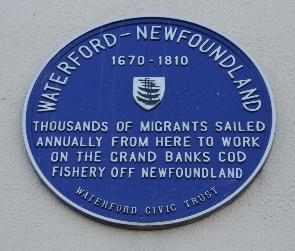NEWFOUNDLAND
Plaque in Waterford recording the place where Irish workers set sail for Newfoundland. Trade between Waterford and Newfoundland contributed greatly to the city’s economy during the eighteenth century. By the beginning of the following century Newfoundland came to be known as “merely Waterford parted by the sea.”
Newfoundland’s Irish were Catholics from the south east of Ireland who first took up employment at the cod fishery as seasonal workers. Despite the poor remuneration and tough working conditions, those Irish with an eye to the future could see the benefits of remaining and becoming permanent residents, with most settling in the Avalon Peninsula.
Because of the limitations of Newfoundland’s agriculture and overall economy, many Irish fishery workers moved to more advantageous locations. By simply crossing to the other side of the Gulf of St. Lawrence they could procure much better farm land and have access to the better-paid jobs which were to be had in eastern Nova Scotia, Cape Breton, Prince Edward Island and the Miramichi River region of New Brunswick. As a result, these regions became settlement strongholds for Irish Catholics who had originated from counties Waterford, Kilkenny, Wexford, Carlow and Tipperary.
In 1840 roughly half of the province’s population had Irish origins, with nearly 75 percent concentrated at or near St. John’s. They dominated the southern shore between Ferryland and Placentia and were the largest part of the population at Harbour Maine, Port de Grave, Harbor Grace and Carbonear along Conception Bay.


